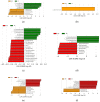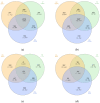Effects of Spartina alterniflora Invasion on Soil Microbial Community Structure and Ecological Functions
- PMID: 33435501
- PMCID: PMC7827921
- DOI: 10.3390/microorganisms9010138
Effects of Spartina alterniflora Invasion on Soil Microbial Community Structure and Ecological Functions
Abstract
It has been reported that the invasion of Spartina alterniflora changed the soil microbial community in the mangrove ecosystem in China, especially the bacterial community, although the response of soil fungal communities and soil microbial ecological functions to the invasion of Spartina alterniflora remains unclear. In this study, we selected three different communities (i.e., Spartina alterniflora community (SC), Spartina alterniflora-mangrove mixed community (TC), and mangrove community (MC)) in the Zhangjiangkou Mangrove Nature Reserve in China. High-throughput sequencing technology was used to analyze the impact of Spartina alterniflora invasion on mangrove soil microbial communities. Our results indicate that the invasion of Spartina alterniflora does not cause significant changes in microbial diversity, but it can alter the community structure of soil bacteria. The results of the LEfSe (LDA Effect Size) analysis show that the relative abundance of some bacterial taxa is not significantly different between the MC and SC communities, but different changes have occurred during the invasion process (i.e., TC community). Different from the results of the bacterial community, the invasion of Spartina alterniflora only cause a significant increase in few fungal taxa during the invasion process, and these taxa are at some lower levels (such as family, genus, and species) and classified into the phylum Ascomycota. Although the invasion of Spartina alterniflora changes the taxa with certain ecological functions, it may not change the potential ecological functions of soil microorganisms (i.e., the potential metabolic pathways of bacteria, nutritional patterns, and fungal associations). In general, the invasion of Spartina alterniflora changes the community structure of soil microorganisms, but it may not affect the potential ecological functions of soil microorganisms.
Keywords: Spartina alterniflora invasion; community structure; ecological functions; funguild analysis; high throughput sequencing; mangrove; soil microbial; tax4fun analysis.
Conflict of interest statement
The authors declare no conflict of interest.
Figures





Similar articles
-
Archaeal and bacterial communities assembly and co-occurrence networks in subtropical mangrove sediments under Spartina alterniflora invasion.Environ Microbiome. 2021 May 3;16(1):10. doi: 10.1186/s40793-021-00377-y. Environ Microbiome. 2021. PMID: 33941277 Free PMC article.
-
Spartina alterniflora invasion reduces soil microbial diversity and weakens soil microbial inter-species relationships in coastal wetlands.Front Microbiol. 2024 Jul 31;15:1422534. doi: 10.3389/fmicb.2024.1422534. eCollection 2024. Front Microbiol. 2024. PMID: 39149207 Free PMC article.
-
Spartina alterniflora invasion alters soil bacterial communities and enhances soil N2O emissions by stimulating soil denitrification in mangrove wetland.Sci Total Environ. 2019 Feb 25;653:231-240. doi: 10.1016/j.scitotenv.2018.10.277. Epub 2018 Oct 21. Sci Total Environ. 2019. PMID: 30412868
-
[Impacts of Spartina alterniflora invasion on coastal wetland ecosystem: Advances and prospects].Ying Yong Sheng Tai Xue Bao. 2020 Jun;31(6):2119-2128. doi: 10.13287/j.1001-9332.202006.032. Ying Yong Sheng Tai Xue Bao. 2020. PMID: 34494766 Review. Chinese.
-
Inhibition of Spartina alterniflora growth alters soil bacteria and their regulation of carbon metabolism.Environ Res. 2023 Nov 1;236(Pt 2):116771. doi: 10.1016/j.envres.2023.116771. Epub 2023 Jul 28. Environ Res. 2023. PMID: 37516267 Review.
Cited by
-
The Effects of Secondary Growth of Spartina alterniflora after Treatment on Sediment Microorganisms in the Yellow River Delta.Microorganisms. 2022 Aug 26;10(9):1722. doi: 10.3390/microorganisms10091722. Microorganisms. 2022. PMID: 36144325 Free PMC article.
-
Community structures of mangrove endophytic and rhizosphere bacteria in Zhangjiangkou National Mangrove Nature Reserve.Sci Rep. 2023 Oct 10;13(1):17127. doi: 10.1038/s41598-023-44447-2. Sci Rep. 2023. PMID: 37816825 Free PMC article.
-
Effects of Spartina alterniflora Invasion on Nitrogen Fixation and Phosphorus Solubilization in a Subtropical Marine Mangrove Ecosystem.Microbiol Spectr. 2022 Jun 29;10(3):e0068221. doi: 10.1128/spectrum.00682-21. Epub 2022 May 23. Microbiol Spectr. 2022. PMID: 35604174 Free PMC article.
-
Spartina alterniflora modifies the native arbuscular mycorrhizal fungal community in coastal ecosystem.Front Microbiol. 2025 Mar 6;16:1544111. doi: 10.3389/fmicb.2025.1544111. eCollection 2025. Front Microbiol. 2025. PMID: 40115193 Free PMC article.
-
Invasion mechanism of Spartina alterniflora by regulating soil sulfur and iron cycling and microbial composition in the Jiuduansha Wetland.Environ Sci Pollut Res Int. 2024 Feb;31(10):14775-14790. doi: 10.1007/s11356-024-32118-2. Epub 2024 Jan 27. Environ Sci Pollut Res Int. 2024. PMID: 38280165
References
-
- Alongi D.M. Present state and future of the world’s mangrove forests. Environ. Conserv. 2002;29:331–349. doi: 10.1017/S0376892902000231. - DOI
-
- Donato D.C., Kauffman J.B., Murdiyarso D., Kurnianto S., Stidham M., Kanninen M. Mangroves among the most carbon-rich forests in the tropics. Nat. Geosci. 2011;4:293–297. doi: 10.1038/ngeo1123. - DOI
-
- Lewis R.R., Milbrandt E.C., Brown B., Krauss K.W., Rovai A.S., Beever J.W., Flynn L.L. Stress in mangrove forests: Early detection and preemptive rehabilitation are essential for future successful worldwide mangrove forest management. Mar. Pollut. Bull. 2016;109:764–771. doi: 10.1016/j.marpolbul.2016.03.006. - DOI - PubMed
Grants and funding
LinkOut - more resources
Full Text Sources
Other Literature Sources

